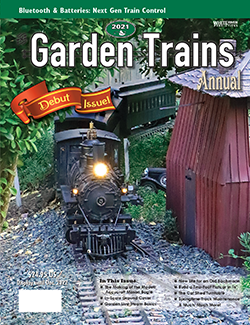 It’s easy to start your first garden railway, combining rugged model trains and beautiful landscaping in your own backyard. Miniature railroads appeared almost immediately after the full-size ones did in the 1840s, and gardens have been popular since that original one called Eden. So it is no wonder garden railways enjoy such a large following. The combination is magical. The first miniature trains were usually indoor toys, starting with simple clockwork mechanisms (wound with a key, a spring stored power to move the gears), then live steam (yes, indoors burning pellets or alcohol!), and finally electric trains made their appearance. As these trains appeared, they were sometimes taken outdoors and enjoyed in gardens. As toy train production increased in Europe, most trains were built to No. 1 gauge, which is 1.75” or 45.45mm. These were nominally scaled to 1:32, meaning the trains were 1/32nd the size of the real train. But that was a loose standard, and other scales were used on that track.
It’s easy to start your first garden railway, combining rugged model trains and beautiful landscaping in your own backyard. Miniature railroads appeared almost immediately after the full-size ones did in the 1840s, and gardens have been popular since that original one called Eden. So it is no wonder garden railways enjoy such a large following. The combination is magical. The first miniature trains were usually indoor toys, starting with simple clockwork mechanisms (wound with a key, a spring stored power to move the gears), then live steam (yes, indoors burning pellets or alcohol!), and finally electric trains made their appearance. As these trains appeared, they were sometimes taken outdoors and enjoyed in gardens. As toy train production increased in Europe, most trains were built to No. 1 gauge, which is 1.75” or 45.45mm. These were nominally scaled to 1:32, meaning the trains were 1/32nd the size of the real train. But that was a loose standard, and other scales were used on that track.
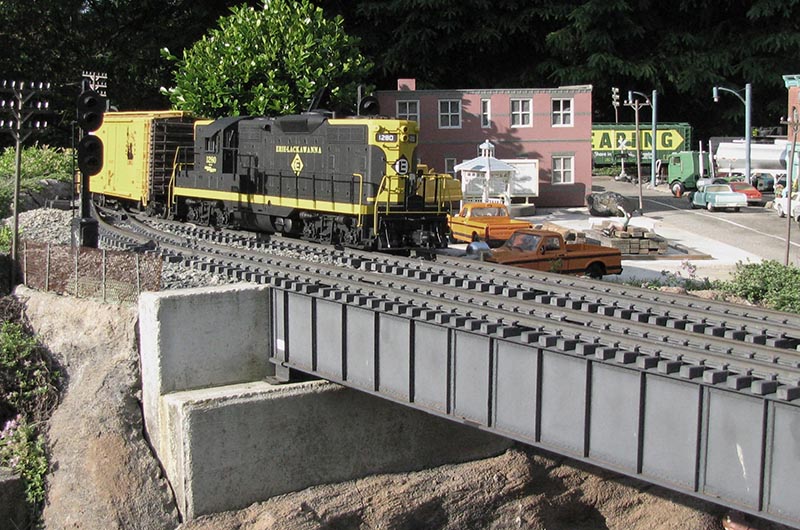
Courtesy of Brandon Trygar/Berkley Garden Railroad
Scale and Gauge
A side discussion of scale versus gauge is in order. Scale is a proportion of the model to the size of the real train. Gauge refers to the distance between the rails. For real (or “prototype”) trains, standard gauge is the United States and most of Europe is 4 foot-8 and-a-half inches, a gauge developed in England as early as 1845. Narrow gauge is anything less; in North America that is usually 3-foot, 2-foot or sometimes 30 inches. In Europe, it is referred to as “meter gauge,” and usually falls between the 2-and 3-foot gauges. Early toy makers were not fussy about scale and simply proportioned the miniatures to resemble the prototype that inspired the model for the track gauge they were using, usually No. 1 gauge (45mm). Soon, other toy companies began producing models to different scale. As hobbyists became more concerned with matters of scale, the term became interchanged with “gauge,” a confusion that persists to this day.
Fast forward to 1968 and the introduction of LGB trains. Lehmann was a very old toy making company dating back to the 1880s, and relocated to Nürnberg, Germany, after the end of World War II. Lehmann Gross Bahn (LGB), literally “Lehmann’s Big Train,” took the large scale hobby by storm. Designed to be used either indoors or out, the track featured weather-resistant ties and rails, and the cars and locomotives were made of very durable plastic and metal parts.
Lehmann chose the old standby No. 1 (45mm) as its gauge, but as the first locomotive and cars were patterned after meter gauge equipment, it chose a scale of 1:22.5. True to its toy maker roots, later offerings patterned after North American and European standard gauge wandered between 1:32 and 1:20.3, depending on the prototype. Soon a host of other manufacturers joined the party, and offered a variety of products in a variety of scales. 1:13.7, 1:20.3, 1:24, 1:22.5, 1:29, and 1:32 were all used, creating confusion among consumers and hobby product providers. Eventually, the term “large scale” can into use to round up all these scales that share the same 45mm track gauge.

Today, 1:32 is used for standard gauge prototype trains in both North America and Europe. 1:29 is a legacy scale used on the former Aristo-Craft line. Some of this tooling is now owned and produced by Bachmann Trains. Piko is currently offering some of its North American-style equipment in this scale as well. LGB continues to produce and sell 1:22.5 scale trains. The 1:24 scale has mostly faded as an active scale for modeling, although many parts produced to this proportion are still sold. Its initial popularity due to it sharing the same scale as most dollhouse items and use for narrow gauge American prototype modeling has been eclipsed by 1:20.3. 1:20.3 is generally used for models of North American, 3-foot gauge prototypes like those that run on the Durango & Silverton and Cumbres & Toltec Scenic railroads. This proportion scales correctly for 45mm track. 1:17.3 (Usually referenced as 7/8” scale) is used to model 2-foot gauge prototype trains on 45mm track.
It really doesn’t matter which scale you choose, as long as you are having fun. Some people choose a large scale based on the availability of their favorite trains. Some modelers choose to build their own equipment, or modify existing models to more closely represent actual trains. Others enjoy the challenge of operating live steam. Either way, the choice is yours!
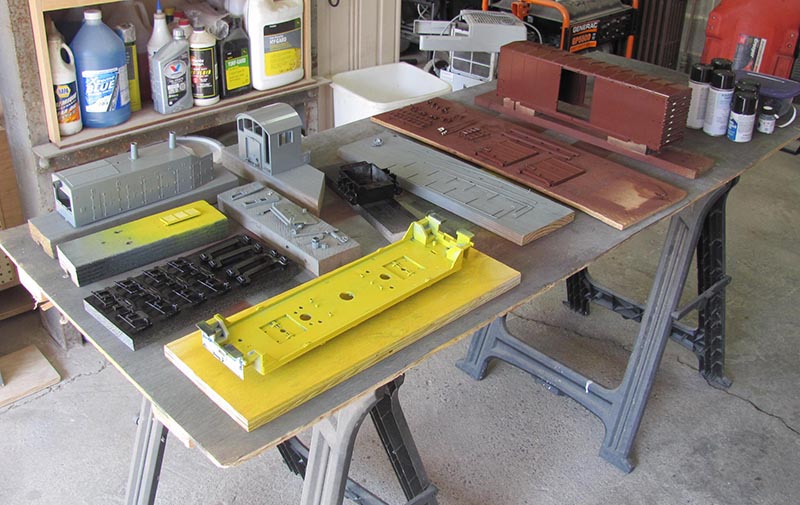
Courtesy of Brandon Trygar/Berkley Garden Railroad
Running in the Great Outdoors
Large scale trains are made to run outside! Some people set up tracks on their decks, around pools, and in and around their gardens and lawns. The track is quite weatherproof and can be left outside, as are many of the scale buildings. Most people bring their trains inside for storage out of the weather, while others build a shed or shelter outside specifically to protect the locomotives and rolling stock. Some even have a layout inside like a traditional model railroad, and the trains transition between indoors and out.
A big part of the fun is being your own Cornelius Vanderbilt or James J. Hill as your build your railroad empire using some of the same skills and engineering as the real thing, just on a much smaller scale. Outdoor landscaping leads itself to the same tunnels, cuts, fills, trestles and bridges found on real railroads, with your imagination and the practical restraints of grades, track radius and clearances being the only limit to how you can configure your layout.

Once you have a plan where you want the track to go, the next step is to prepare the subroadbed. This is easily accomplished with basic gardening tools. The fundamentals are the same as a real railroad; you want the roadbed to drain and not pool water in low areas, the grades must be modest enough for your locomotives to pull cars over and you want to avoid any sharp changes in curves or grades. Next, a roadbed is prepared. On real trains, that consists of a thick layer of ballast (crushed stone) that the ties and rails are laid on. Then more ballast is placed between the ties to lock the ties into place. In miniature, decomposed granite or poultry grit make excellent ballast. The track is laid and aligned, and once tested for reliability, you are off and running.
Powering Your Trains
In the early days of large scale railroading, trains were powered by wires running to the rails, just as in indoor model railroads. Power is picked up by wheels, sliders or a combination of the two contacting the rails, and that power runs an electric motor within the locomotive. The outdoor environment brings some challenges to this. Brass or aluminum rail is used outdoors for their durability, but both metals corrode with an oxidation that does not conduct electricity, which can make the rail/wheel connection tenuous. Frequent scrubbing of the rails is required to keep the contact strong, and leaves, twigs, grass clippings and other out of scale debris can also foul the rails.
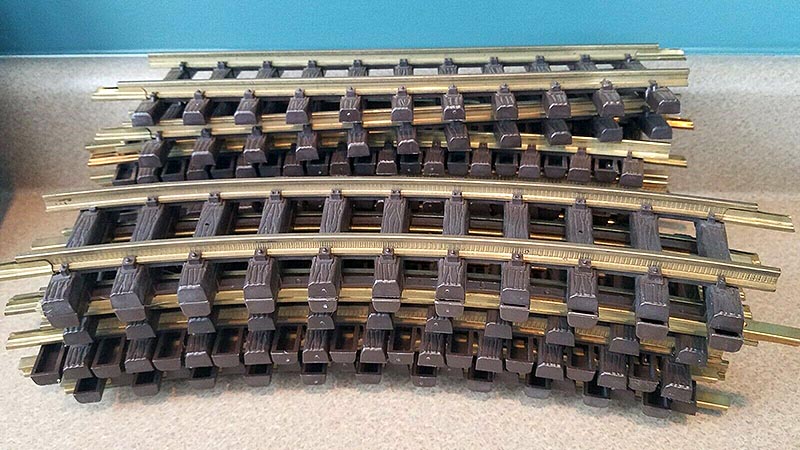
For this reason, large scale railroaders were early adopters of battery power, often referred to as “Deadrail.” Power to run the train is stored in an onboard battery and transferred to the motor through a receiver of some type. There are a number of commercial systems for this and many built their own using radio-control car and airplane components. The rail’s function is only to keep the train’s wheels rolling along, so cleaning for electrical contact is eliminated.
Many enjoy operating live steam locomotives outdoors. These locomotives carry their own fuel and water and can happily run on either Deadrail or regular electrically powered tracks. They are often configured with RC receivers and servos to operate the throttle and reversing lever. And many people run a mix of power on their layouts.
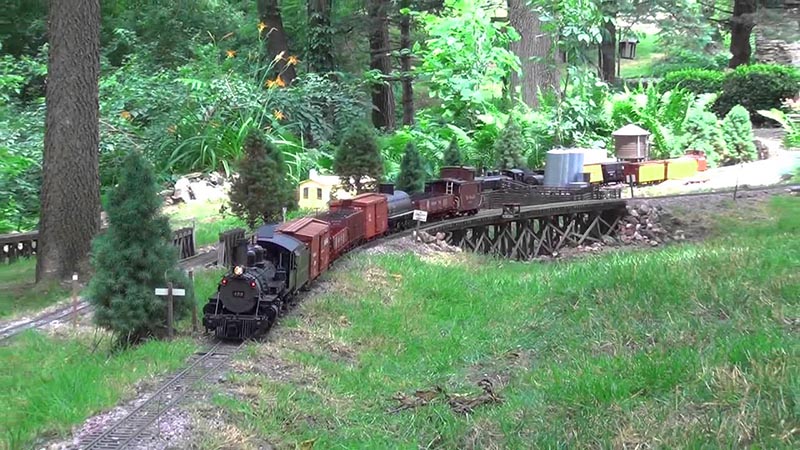
Gardening and Garden Trains
If you have a yard, there will be yard work, but many enjoy gardening and landscaping and by adding trains, it can be a very enjoyable couples activity. Often one party will have a preference for the trains and the other the garden, but garden railroading is having one’s cake and eating it too. Few activities can match the enjoyment derived from sipping your favorite beverage in the evening, and operating trains through the beautiful garden you worked in earlier in the day. It is a fine reward for your efforts. This sound fun? It is, and it takes little to start. You just need a train, some track and some outdoors, and you are a member of the great hobby of garden railroading.
—Chris Lane, Editor




